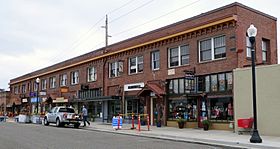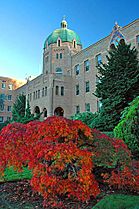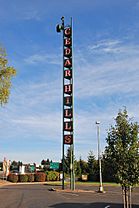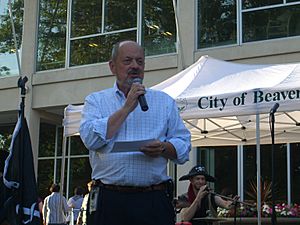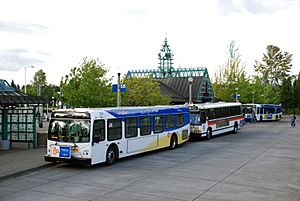Beaverton, Oregon facts for kids
Quick facts for kids
Beaverton, Oregon
|
|||
|---|---|---|---|
|
City
|
|||
|
From top: Edward Earl Fisher Building in the Beaverton Downtown Historic District, Sisters of St. Mary of Oregon, Cedar Hills neon sign, Beaverton City Library
|
|||
|
|||
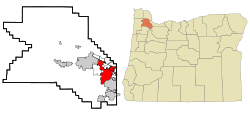
Location in Oregon
|
|||
| Country | United States | ||
| State | Oregon | ||
| County | Washington | ||
| Incorporated | 1893 | ||
| Area | |||
| • Total | 19.58 sq mi (50.72 km2) | ||
| • Land | 19.58 sq mi (50.72 km2) | ||
| • Water | 0.00 sq mi (0.00 km2) 0% | ||
| Elevation | 189 ft (58 m) | ||
| Population
(2020)
|
|||
| • Total | 97,494 | ||
| • Density | 4,979.3/sq mi (1,922.20/km2) | ||
| Time zone | UTC−8 (Pacific (PST)) | ||
| • Summer (DST) | UTC−7 (PDT) | ||
| ZIP codes |
97003, 97005-97008, 97075-97078
|
||
| Area codes | 503 and 971 | ||
| FIPS code | 41-05350 | ||
| GNIS feature ID | 1637830 | ||
| Website | City of Beaverton | ||
Beaverton is a city in Washington County, in the U.S. state of Oregon that is located 7 miles (11 km) west of Portland in the Tualatin Valley. The city is among the main cities that make up the Portland metropolitan area. Its population was 97,494 at the 2020 census, making it the second-largest city in the county and the seventh-largest city in Oregon. Beaverton is an economic center for Washington County along with neighboring Hillsboro. It is home to the world headquarters of Nike, Inc., although it sits outside of city limits on unincorporated county land.
The hunter–gatherer Atfalati tribe of the Kalapuya people inhabited the Tualatin Valley prior to the arrival of European–American settlers in the 19th century. They occupied a village near the Beaverton and Fanno creeks called Chakeipi, which meant "place of the beaver", and early white settlers referred to this village as Beaverdam. Lawrence Hall took up the first land claim in 1847 and established a grist mill. The entry of a railroad in 1868 spurred growth in the small farming communities and led to the town's incorporation in 1893.
Contents
History
Etymology
According to Oregon Geographic Names, Beaverton's name is derived from the settlement's proximity to a large body of water resulting from beaver dams.
Native Americans
The area of Tualatin Valley which became Beaverton was originally the home of a Native American tribe known as the Atfalati, which settlers mispronounced as Tualatin. The Atfalati population dwindled in the latter part of the 18th century, and the prosperous tribe was no longer dominant in the area by the 19th century when settlers arrived.
19th century
Early settlers
The natives had a village called Chakeipi, meaning Place of the Beaver, and early settlers referred to it as "Beaverdam". Early settlers include the Hall Family from Kentucky, the Denneys who lived on their claim near present-day Scholls Ferry Road and Hall Blvd, and Orin S. Allen, from western New York. Lawrence Hall purchased 640 acres (2.6 km2) in Beaverdam in 1847 and built a grist mill with his brother near present-day Walker Road. His was the first land claim in the area. He was soon followed by Thomas Denney in 1848, who came to the area and built its first sawmill. In 1860, a toll plank road from Portland to Beaverton was completed over a trail called Canyon Road.
Beginning of the town
After the American Civil War, numerous other settlers, including Joshua Welch, George Betts, Charles Angel, W. P. Watson, and John Henry, laid out what is now known as Beaverton hoping they could bring a railroad to an area once described as, "mostly swamps & marshes connected by beaver dams to create what looked like a huge lake." In 1872, Beaverton's first post office opened in a general store operated by Betts, who also served as the first postmaster of the community. Betts Street, where the current post office now stands, is named in honor of him. In 1893, Beaverton, which by that time had a population of 400, was officially incorporated. Alonzo Cady, a local businessman, served as the first mayor. Many major roads in Beaverton are named for these early settlers.
20th century
Automobile dealerships
Beaverton was an early home to automobile dealerships. A Ford Motor Company dealership was established there in 1915; it was purchased by Guy Carr in 1923 and over the years Carr expanded it into several locations throughout Beaverton. There are still several dealerships near the intersection of Walker and Canyon Roads.
Movies and airplanes
In the early 1920s, Beaverton was home to Premium Picture Productions, a movie studio which produced about fifteen films. The studio site was later converted into Watt's Field and associated aircraft manufacturing facilities. A second Beaverton airport, Bernard's Airport, was later developed farther north, at the present location of the Cedar Hills Crossing mall.
Library
The town's first library opened in 1925. Originally on the second floor of the Cady building, it has moved repeatedly; in 2000 it was moved to its current location on Hall Boulevard and 5th Street. A branch location was opened for the first time in June, 2010, when the Murray-Scholls location opened near the Murrayhill neighborhood. The Beaverton libraries and 15 other local libraries participate in the Washington County Cooperative Library Services.
Mass transit
In the 1940s, Tualatin Valley Stages, a division of Portland Stages, Inc., provided limited bus transit service connecting the city with downtown Portland, operating later as a separate company, Tualatin Valley Buses, Inc., through the 1960s. This was one of four privately owned bus companies serving the Portland metropolitan area which became collectively known as the "Blue Bus" lines. All four companies were replaced in 1970 by TriMet, a then-new regional transit authority, which expanded bus service to cover more areas of Beaverton.
In the late 1970s, a light rail system was proposed to connect Beaverton to downtown Portland, as part of Metro's plans for the region's transportation. In 1990, voters approved funding for Westside MAX. Construction of the line began in 1993 and was completed in 1998. Six stations are located within the city of Beaverton: Elmonica/SW 170th Avenue, Merlo Road/SW 158th, Beaverton Creek, Millikan Way, Beaverton Central, and the Beaverton Transit Center. All but the last of these (the transit center) are located along right-of-way formerly owned by Burlington Northern Railroad and originally by the Oregon Electric Railway, which provided interurban service through Beaverton until 1933. The present-day light rail service (MAX) is operated by TriMet, which also continues to operate several bus routes serving Beaverton and the surrounding communities. Since early 2009, Beaverton has also been served by commuter rail service, TriMet's Westside Express Service (WES), running south to Wilsonville via Tigard and Tualatin.
21st century
Expansion
In December 2004, the city and Washington County announced an "interim plan" which would lead to Beaverton becoming the second-largest city in Oregon, second only to Portland. The "interim" plan actually covered a period of more than ten years; from the county's perspective, the plan supported its strategy of having cities and special districts provide urban services. The city of Beaverton also attempted to annex certain businesses, including Nike, which responded with a legal and lobbying effort to resist the annexation. The lobbying effort succeeded quickly, with the Oregon Legislative Assembly enacting Senate Bill 887, which prohibited Beaverton from annexing Nike without the company's consent. The bill also applied to property owned by Electro Scientific Industries, Columbia Sportswear, and Tektronix, and in August 2008 the Oregon Land Use Board of Appeals ruled that the bill also barred the city from annexing property belonging to Leupold & Stevens. (See below, under Economy.) Nike's legal efforts to resist annexation cost Beaverton taxpayers over $360,000 as of July 2006[update].
The Oregon State Legislature has also passed legislation which redetermined Washington County's urban growth boundary to include more development.
Transit-oriented development
The city has tried to encourage transit-oriented development around the city's MAX Light Rail stations. The Round, a mixed-use development around Beaverton Central MAX Station on the site of a former sewer plant, was originally announced in 1996. It is only partially complete, due to the bankruptcy of one developer and the Great Recession. In 2014, the City of Beaverton moved its city hall into a vacant office building in The Round. Further development and an arts center have been proposed for the former site of the Westgate Theatre, adjacent to The Round.
Geography
According to the United States Census Bureau, the city has a total area of 18.73 square miles (48.51 km2), all land except small creeks, ponds, and lakes.
Climate
| Climate data for Beaverton, Oregon | |||||||||||||
|---|---|---|---|---|---|---|---|---|---|---|---|---|---|
| Month | Jan | Feb | Mar | Apr | May | Jun | Jul | Aug | Sep | Oct | Nov | Dec | Year |
| Record high °F (°C) | 66 (19) |
73 (23) |
79 (26) |
94 (34) |
100 (38) |
103 (39) |
106 (41) |
105 (41) |
101 (38) |
91 (33) |
72 (22) |
64 (18) |
106 (41) |
| Average high °F (°C) | 46 (8) |
51 (11) |
56 (13) |
61 (16) |
67 (19) |
73 (23) |
79 (26) |
80 (27) |
75 (24) |
64 (18) |
52 (11) |
46 (8) |
63 (17) |
| Average low °F (°C) | 34 (1) |
35 (2) |
37 (3) |
40 (4) |
45 (7) |
51 (11) |
54 (12) |
54 (12) |
50 (10) |
43 (6) |
39 (4) |
35 (2) |
43 (6) |
| Record low °F (°C) | 10 (−12) |
8 (−13) |
19 (−7) |
27 (−3) |
31 (−1) |
33 (1) |
41 (5) |
36 (2) |
34 (1) |
26 (−3) |
9 (−13) |
0 (−18) |
0 (−18) |
| Average precipitation inches (mm) | 5.83 (148) |
4.84 (123) |
4.06 (103) |
2.79 (71) |
2.25 (57) |
1.62 (41) |
0.68 (17) |
0.84 (21) |
1.64 (42) |
2.92 (74) |
6.07 (154) |
6.41 (163) |
39.95 (1,015) |
Demographics
| Historical population | |||
|---|---|---|---|
| Census | Pop. | %± | |
| 1900 | 249 | — | |
| 1910 | 386 | 55.0% | |
| 1920 | 580 | 50.3% | |
| 1930 | 1,138 | 96.2% | |
| 1940 | 1,052 | −7.6% | |
| 1950 | 2,512 | 138.8% | |
| 1960 | 5,937 | 136.3% | |
| 1970 | 18,577 | 212.9% | |
| 1980 | 31,962 | 72.1% | |
| 1990 | 53,310 | 66.8% | |
| 2000 | 79,277 | 48.7% | |
| 2010 | 89,803 | 13.3% | |
| 2020 | 97,494 | 8.6% | |
| U.S. Decennial Census 2018 Estimate |
|||
As of 2020 the median income for a household in the city was $38,261, and the median income for a family was $71,806. Males had a median income of $41,683 versus $31,204 for females. The per capita income for the city was $25,419. About 5.0% of families and 7.8% of the population were below the poverty line, including 8.5% of those under age 18 and 6.8% of those age 65 or over.
2010 census
As of the census of 2010, there were 89,803 people, 37,213 households, and 21,915 families residing in the city. The population density was 4,794.6 inhabitants per square mile (1,851.2/km2). There were 39,500 housing units at an average density of 2,108.9 per square mile (814.3/km2). The racial makeup of the city was 73.0% White, 2.6% African American, 0.6% Native American, 10.5% Asian, 0.5% Pacific Islander, 8.2% from other races, and 4.5% from two or more races. Hispanic or Latino of any race were 16.3% of the population.
There were 37,213 households, of which 31.0% had children under the age of 18 living with them, 43.7% were married couples living together, 10.6% had a female householder with no husband present, 4.6% had a male householder with no wife present, and 41.1% were non-families. 30.9% of all households were made up of individuals, and 8.5% had someone living alone who was 65 years of age or older. The average household size was 2.39 and the average family size was 3.03.
The median age in the city was 34.7 years. 22.9% of residents were under the age of 18; 9.2% were between the ages of 18 and 24; 33% were from 25 to 44; 24.5% were from 45 to 64; and 10.4% were 65 years of age or older. The gender makeup of the city was 48.6% male and 51.4% female.
Sister cities
Since 1987, Beaverton has established sister city relationships with six foreign cities:
| Country | City | Year of Partnership |
|---|---|---|
| Gotenba | 1987 | |
| Hsinchu | 1988 | |
| Cheonan | 1989 | |
| Birobidzhan | 1990 | |
| Trossingen | 1993 | |
| Cluses | 1999 |
Economy
Company headquarters
Reser's Fine Foods, processor and distributor of fresh prepared foods, has headquartered in Beaverton since 1960. Leupold & Stevens, maker of rifle scopes and other specialty optics, has been located on property adjacent to the City of Beaverton since 1968. The Beaverton City Council annexed that property in May 2005, and Leupold & Stevens challenged that annexation. The company eventually won the legal fight in 2009 with the city, thus the company was de-annexed from the city. Beaverton is home to the world headquarters of Nike, Inc. Its headquarters are located on an unincorporated area inside, but excluded from, Beaverton city limits. Significant amounts of construction and development have taken place on the Nike Campus throughout the 2010s heading into the 2020s.
Technology companies
As part of the Silicon Forest, Beaverton is the location of numerous technology organizations and companies, including Linux Technology Center of IBM, Tektronix, Maxim Integrated Products, VeriWave, and Oregon Technology Business Center (OTBC), a non-profit tech startup incubator. Phoenix Technologies operates its Northwestern Regional Office in Beaverton.
Largest employers
According to the City's 2021 Comprehensive Annual Financial Report, the largest employers in the city are:
| # | Employer | # of Employees |
|---|---|---|
| 1 | Nike | 6,019 |
| 2 | Beaverton School District | 4,458 |
| 3 | Comcast Cable | 769 |
| 4 | Fred Meyer | 726 |
| 5 | City of Beaverton | 692 |
| 6 | Home Depot | 406 |
| 7 | Pacific Office Automation | 398 |
| 8 | TEKsystems | 365 |
| 9 | Lanphere Enterprises | 354 |
| 10 | New Seasons Market | 351 |
Tourist attractions
- Beaverton Farmer's Market
- BG's Food Cartel
- Cooper Mountain Nature Park
- Cooper Mountain Vineyards
- Hyland Forest Park
- Patricia Reser Center for the Arts
- Red Tail Golf Center
- Tualatin Hills Nature Park
- Veterans Memorial Park
- Jenkins Estate
Shopping
Cedar Hills Crossing is a shopping mall within the city of Beaverton. Facilities include a variety of restaurants, big-box retailers, a bowling alley, and more.
Sports
The Howard M. Terpenning Recreation Complex, opened in 1978, features swimming, athletics, tennis, baseball, softball and basketball facilities.
Little League
In 2014, the Beaverton–Aloha Little League Intermediate baseball team won the state tournament and traveled to Nogales, Arizona to play in the regional tournament, where they accumulated a 2–2 record.
In 2006, the Murrayhill Little League baseball team qualified for the 2006 Little League World Series, the first Oregon team in 48 years to go that far. Murrayhill advanced to the semi-finals before losing; the third-place game was rained out and not rescheduled. In addition, a Junior Softball team from Beaverton went to 2006 World Series in Kirkland, Washington, ending in sixth place.
In 2002, Beaverton's Little League Softball team took second place to Waco, Texas, in the Little League Softball World Series.
Curling
In January 2013, Beaverton became the first city in Oregon to have an ice rink dedicated to the sport of curling, the Evergreen Curling Club. In January 2017, the Evergreen Curling Club hosted the United States Curling Association Senior Women's National Championship.
Education
The public schools of Beaverton are part of the Beaverton School District. There are six public high schools in the district – Aloha High School, Beaverton High School, Mountainside High School, Southridge High School, Sunset High School, and Westview High School. It also has several public option schools serving grades 6 - 12 like the International School of Beaverton, Arts and Communication Magnet Academy, and Beaverton Academy of Science and Engineering. Merlo Station High School is another alternative learning school with in the district. Private schools in the area include German American School, Holy Trinity School, Jesuit High School, Saint Cecilia Grade School, Southwest Christian School, Valley Catholic School, and WoodHaven School.
Colleges and universities
- Portland Community College (PCC — Although it is based in Portland, some facilities operate in Beaverton.)
Infrastructure
Fire protection is provided through Tualatin Valley Fire and Rescue. EMS services are provided by Metro West Ambulance.
Transportation
Beaverton is served by transit bus, commuter rail, and light rail services operated by the Portland metropolitan area's regional transit agency, TriMet. MAX Light Rail serves the city with seven light rail stations; from west to east, they are: Elmonica/Southwest 170th Avenue, Merlo Road/Southwest 158th Avenue, Beaverton Creek, Millikan Way, Beaverton Central, Beaverton Transit Center, and Sunset Transit Center. The MAX Blue Line serves all seven stations while the MAX Red Line serves only Beaverton Transit Center and Sunset Transit Center. Beaverton Transit Center, TriMet's busiest transit center, in addition to MAX, serves as a transit hub for bus routes mostly operating on the west side and as the northern terminus of WES Commuter Rail. Hall/Nimbus, the second station southbound on WES, is also located in Beaverton. Intercity bus services with stops in Beaverton include POINT and TCTD.
Oregon Electric and Red Electric interurban lines once served the city in the early 20th century. In the 1940s, Tualatin Valley Stages, a division of Portland Stages, Inc., provided limited bus transit service between the city and downtown Portland; it operated later as a separate company, Tualatin Valley Buses, Inc., through the 1960s. This was one of four privately owned bus companies that served the Portland metropolitan area and were collectively known as the "Blue Bus" lines. All four companies were replaced in 1970 by TriMet, which expanded bus service to cover more areas of Beaverton.
The city is the location of a major freeway interchange for U.S. Route 26 (US 26; Sunset Highway) and Oregon Route 217 (OR 217). The Sunset Highway connects Beaverton to Hillsboro and the Oregon Coast to the west and Portland to the east. OR 217 travels from Beaverton south through Tigard and terminates at an interchange with Interstate 5 (I-5).
Notable people
- James Allsup – far-right political commentator
- Charles E. Bernard – aviator
- John Brotherton – actor
- Mike Byrne – drummer for The Smashing Pumpkins
- Janet Chvatal – actress
- Grace Crunican – general manager for Bay Area Rapid Transit
- Ward Cunningham – inventor of the wiki
- Brad Fitzpatrick – programmer
- Ted Geoghegan – screenwriter
- Barrie Gilbert – inventor
- Erik Hurtado – professional soccer player
- Ian Karmel – stand-up comedian and writer
- Gloria Calderon Kellett – writer
- Anne Kenney – television producer
- Morten Lauridsen – composer
- Michael McQuilken – director
- Moultrie Patten – jazz musician
- Rubio Rubin – professional soccer player
- Ari Shapiro – radio journalist
- Royal Skousen – professor
- Todd Snider – musician
- Courtney Taylor-Taylor – lead singer of The Dandy Warhols
- James B. Thayer – United States Army brigadier general
- Tommy Thayer – lead guitarist for Kiss
Images for kids
See also
 In Spanish: Beaverton para niños
In Spanish: Beaverton para niños


